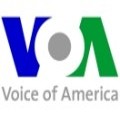'Great Race' Re-creates 1908 Competition
The 1908 Great Race captured the world's imagination, and later inspired a film, called The Great Race, starring Jack Lemmon, Tony Curtis and Natalie Wood. "It is the fabulous around-the-world race from New York to Paris - a rambunctious, rib-busting riot of a race." As a child, Jeff Mahl often heard stories about the race from his great grandfather, George Schuster Senior. A mechanic for the Thomas Motor Company of Buffalo, New York, Schuster drove a 1907 Thomas Flyer for the only American team entered in the 35,000 kilometer race. Mahl notes the competition began in New York City on February 12, in the depths of the winter.
"There were no snow plows, of course, in those days, so even crossing the United States, they ran into a storm outside of Toledo," Mahl says. "And they would have to hook teams of horses onto the car and literally drag it. Sometimes they would have six to eight horses on the car at any one time dragging the Thomas Flyer through the snow drifts." Six teams of racers - one German, three French, one Italian and one American - intended to drive across the Bering Strait, but that was impractical, so they ended up sailing from San Francisco to Japan. They crossed Japan by car, then sailed to Vladivostok and drove across Asia and Europe, ending at the Eiffel Tower in Paris.
Steve Sanborn, one of the organizers for the 2008 Great Race, says the route this time will be slightly different.
"It will head across the United States and then will ship to Shanghai, and will go through China, through Mongolia into Eastern Siberia, and then across into Moscow, and down into Eastern Europe though Belarus, Poland, Czech Republic, Austria, Switzerland, Germany, and then will end in Paris, France," Sanborn says. In 1908 the American team finished first, reaching Paris in 169 days. This time, organizers expect the winner to finish in 80 days, after treasure hunts and rally competitions along the way.
Speed is just one factor in determining the winner. The other measures are endurance and success in the series of competitions.
Sanborn says the 1908 race highlighted the technology of the time, and this race will do the same. Entries must use alternative fuels, such as ethanol or an ethanol-gasoline mixture, electric or hydrogen fuel cells, or other state-of-the-art technology.
He says the race will send a message.
"We'd like to see consumers worldwide start to really take a look at their use of oil and how much they really do use, and view the automobile as a way to help reduce that consumption and help improve the environment," Sanborn says. Sanborn says a second race division will feature classic auto technology in vehicles manufactured before 1970.
He says the 2008 race should be truly international.
"We are looking for teams from all over the world. We would love to have an Indian team," Sanborn says. "We would love to have Japanese teams. We would love to have teams from every nation." Jeff Mahl says his great grandfather and his winning 1908 team had to be creative in the years before highways were built. He says the drivers straddled railway tracks where they could find them, driving over the rail ties.
"And of course with balloon tires, blew out dozens of tires every stretch of the way that they took the railroad," Mahl ssays. "So it was a daily ordeal for 169 days." He says his great grandfather's team won through endurance, skill, and luck. "In the expanses of Siberia and Manchuria and some other parts of the world, there were no repair shops, so it took a lot of Yankee ingenuity along the way, and a good bit of luck," Mahl ssays. In 1908, only three of the six teams finished, the winning U.S. entry, the runner-up from Germany, and the third-place team from Italy. Steve Sanborn says perseverance and talent will be needed to the win the new race.
The winner this time will receive $1 million. Organizers will announce those teams selected to join the race early next year, and the race is scheduled to start in New York February 12, 2008, exactly 100 years after the original Great Race began.

